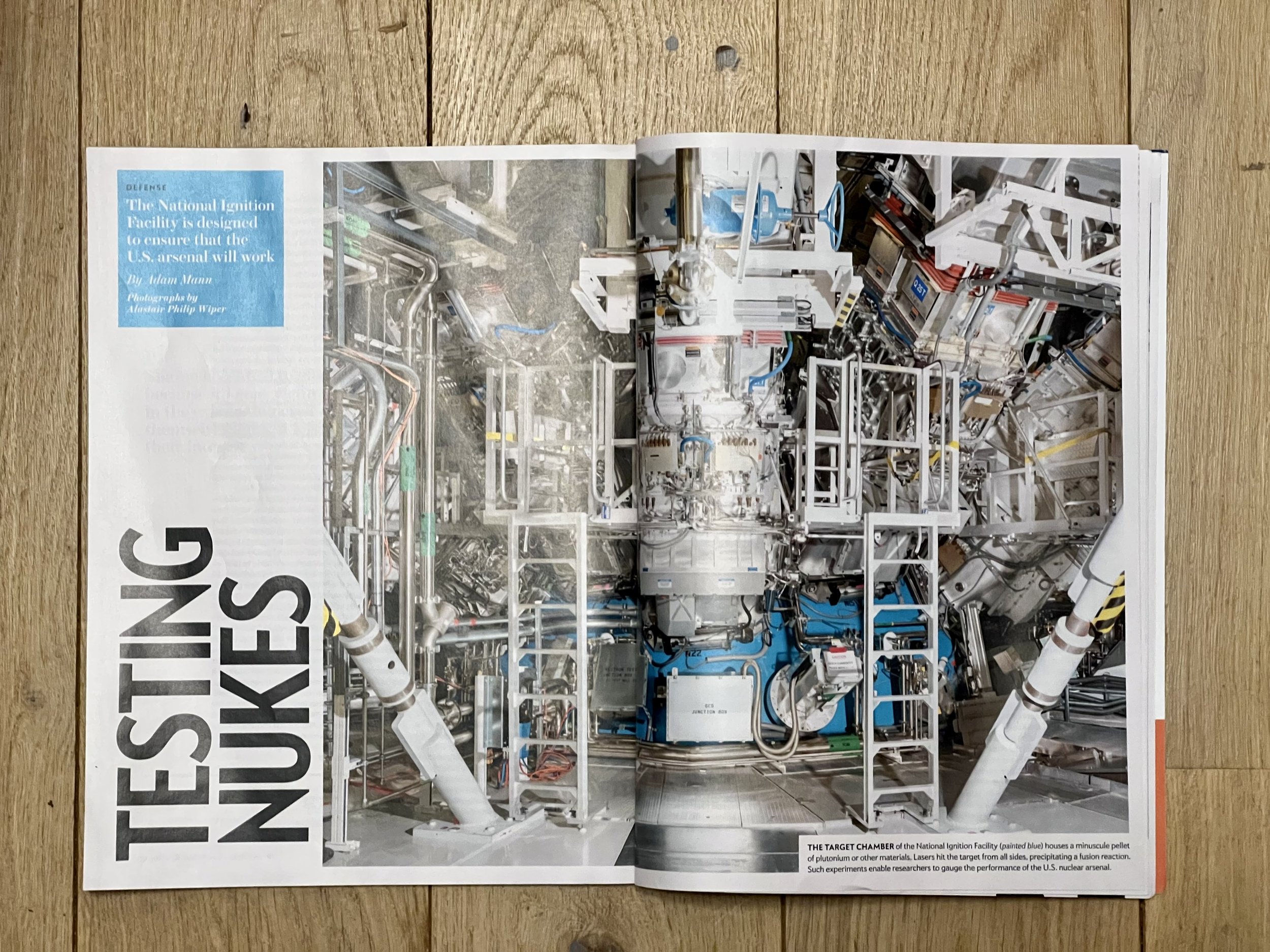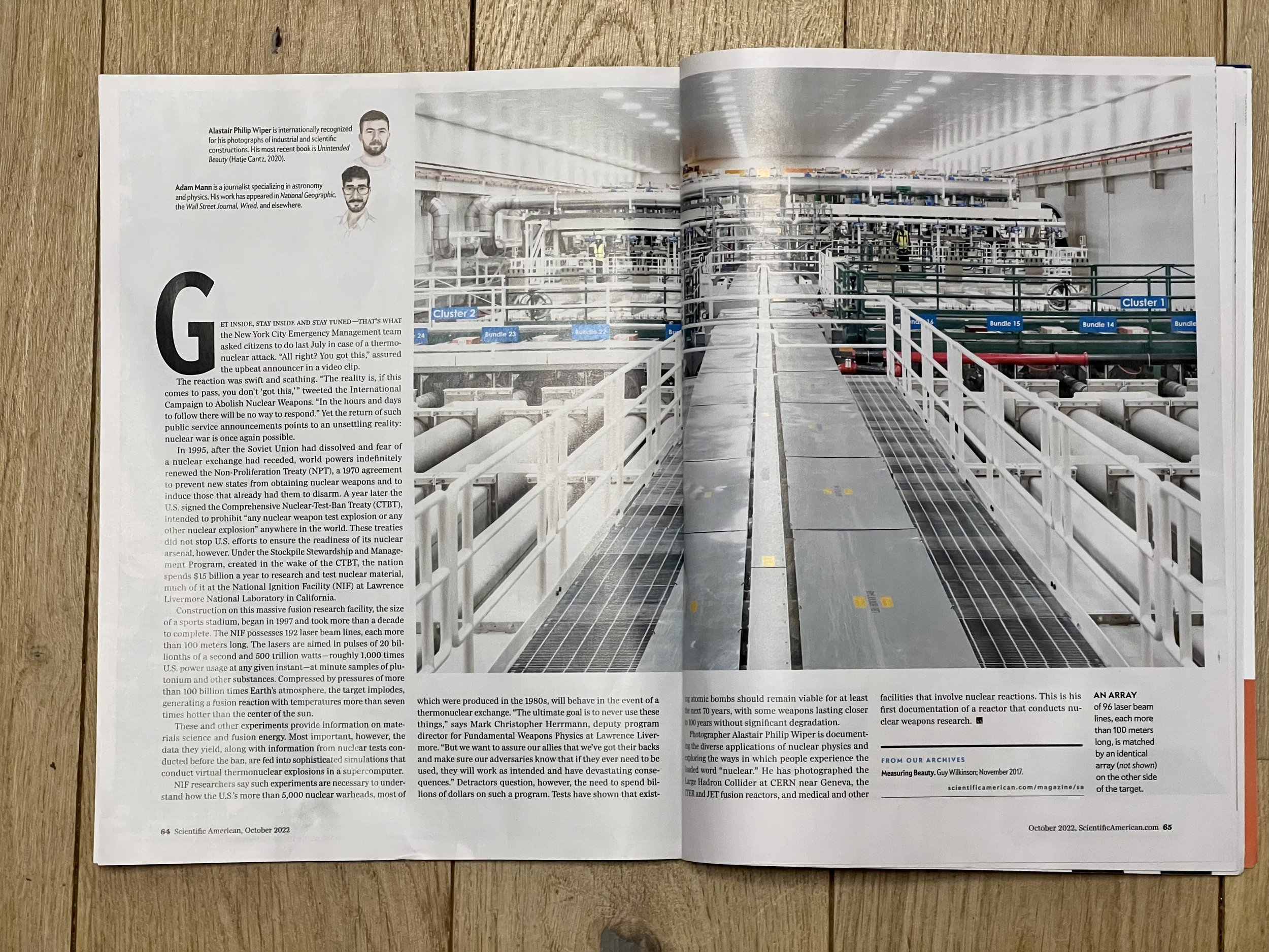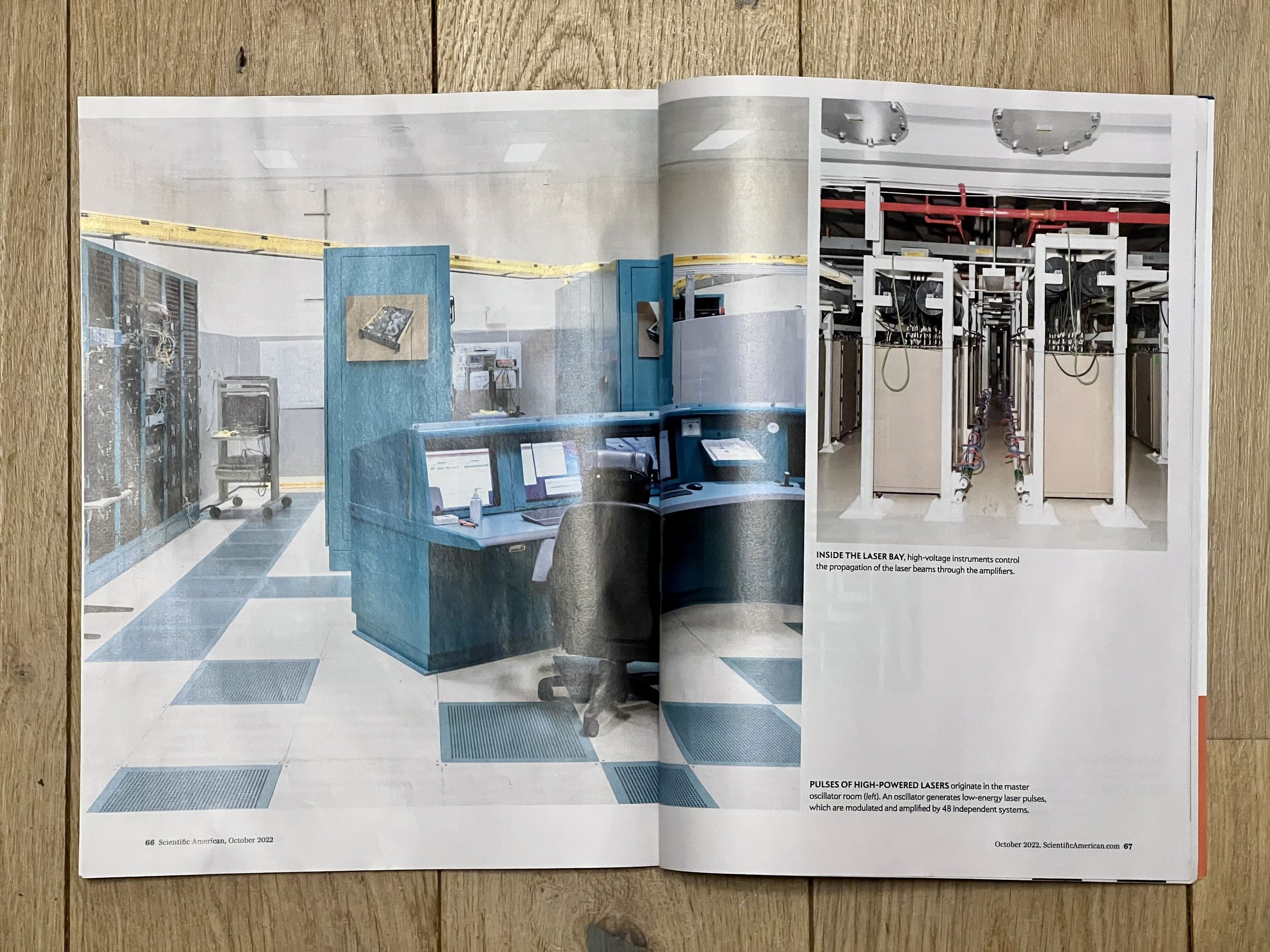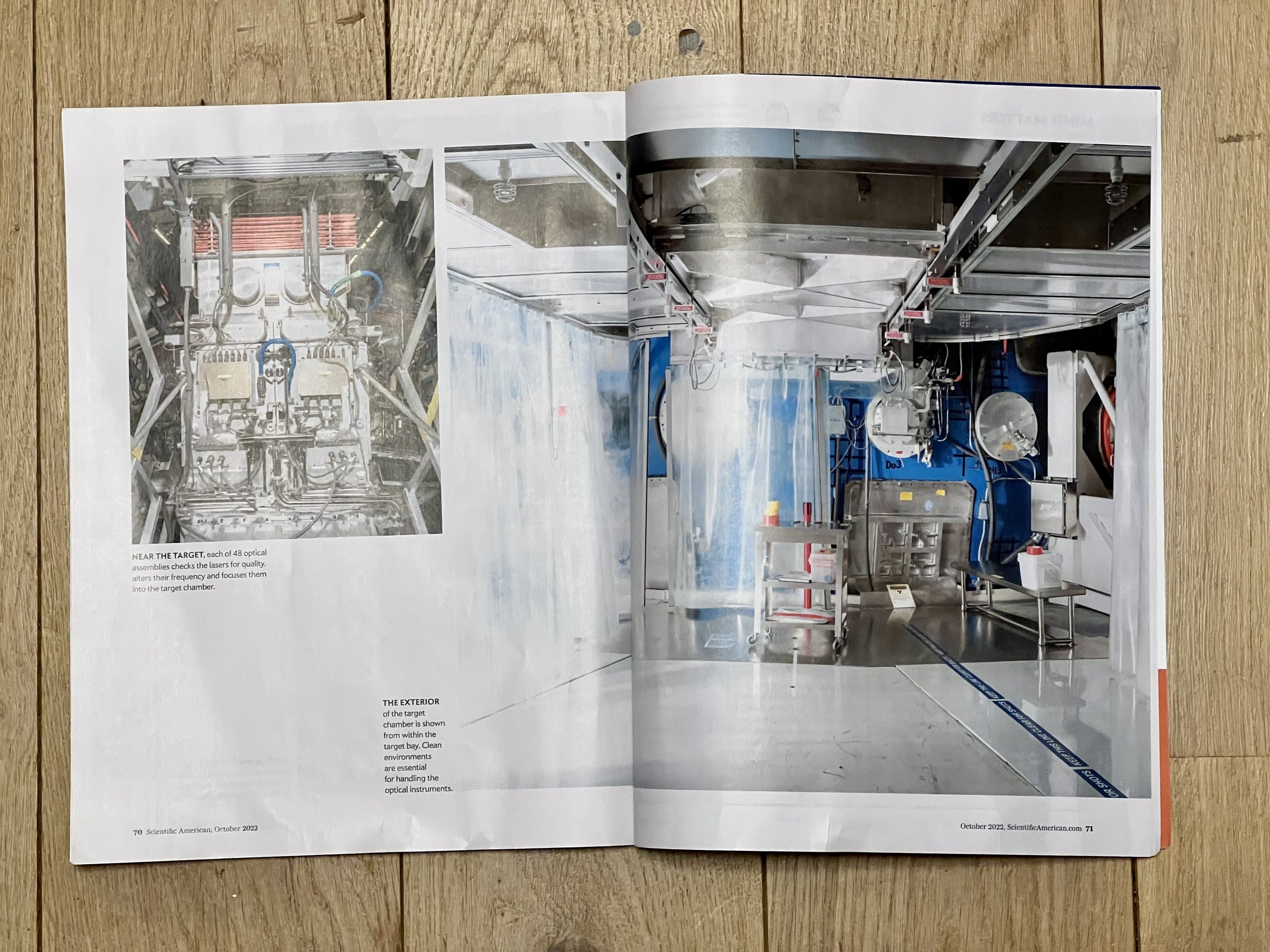*Featured in Scientific American October 2022.
**On December 5th 2022, the National Ignition Facility made an epic breakthrough in nuclear fusion research by creating, for the first time, a reaction that produced more energy than was put into it.
Exterior of the NIF Target Chamber, within the Target Bay. Pulses from NIF’s 192 high-powered lasers race through the facility at the speed of light, and arrive at the center of the target chamber (shown in blue) within a few trillionths of a second of each other, aligned to the accuracy of the diameter of a human hair.
“It's like a car that you've parked out in your garage for 30 years, and it's your rescue vehicle, but you can't test it until you actually need it” explains Bruno. He is telling me what the largest laser in the world is used for.
“The basic challenge that we are facing is that we have a stockpile of nuclear weapons that was designed and built many years ago, anywhere between 10 to 50 years ago. And since the early '90s, we have not been able to conduct any tests any longer. So, in the meantime, the materials age, the equipment ages, the electronics age, and we have to make sure that every year we can certify that the stockpile will work when it is needed as a deterrent or when the president makes the decision to deploy it. So, you need to have weapons that will work after 30 years of storage, that can be loaded on a missile or on a plane, and that they will function. And that is of course, a very difficult challenge without testing.”
Inside the Laser Bay. The NIF laser is built high up in the air supported on massive pedestals so that optical components from below can be loaded and unloaded to maintain extremely clean environments, similar to semiconductor manufacturing. Optical components are handled in clean room canisters that are transported using guided vehicles docking to the bottom of the laser above.
I’m talking to Bruno Van Wonterghem, Operations Manager at the National Ignition Facility (NIF), part of the Lawrence Livermore National Laboratory in California. A critical task of the laboratory is ensuring the safety, security, and reliability of the USA's nuclear weapons through science, engineering, and technology. The last time the USA tested a nuclear bomb was in 1992, and when they made the decision to stop full-scale testing, they needed to find a way to make sure that the bombs that they had would continue to work, the people stay trained, and the physics is up to date. And that is why NIF was born.
NIF laser pulses are born in the master oscillator room, in which a compact laser oscillator generates low-energy (a few nanojoules) laser pulses. The oscillator pulse is shaped in time and frequency-broadened, using the small range of multiple wavelengths produced in the fiber laser, to help smooth the intensity of the laser beam when it is ultimately focused on the target. There are 48 independent pulse shaping systems, and each of the pulses is transported on separate fiber optic cables to 48 preamplifier modules for further amplification.
Bruno, who earned his PhD in chemical physics in Belgium in 1987 and has worked at NIF since 1992, goes on. “The laser is used to create extreme temperatures and pressures and recreate conditions that can only be found in stars or in the interior of planets. But for the laboratory, of course, very importantly, inside a nuclear weapon.”
The laser system is about three football fields in length, about 200 meters long, 100 meters wide, and 20 meters high. “It is a monster laser. It is the largest laser ever built, and it is the first laser system engineered to be this efficient to work so reliably. And it took us 20 years to build that machine,” says Bruno.
NIF operators and experimenters meet together next to the control room to discuss the details of the experiment, the laser settings, target and diagnostics for the expected results.
The laser is focused on a plastic-coated pellet about the size of a pencil tip, inside a 10m wide circular chamber, surrounded by a six-foot-thick concrete wall. The lasers take 60 seconds or so to charge and then fire a pulse about 10 billionths of a second long. The energy from the laser is so intense that it causes the plastic to implode, squeezing down on the fuel inside to the width of a human hair. The temperature is raised to hundreds of millions of degrees, allowing nuclear fusion to occur. The energy that is released, for one trillionth of a second, exceeds the sun's total power on the earth's surface.
Exterior of the NIF Target Chamber, within the Target Bay. Optical components are handled in local clean environments surrounding the laser beampath connected to the target chamber.
That release of fusion power leads to an important bi-product of NIF, research into nuclear fusion as a sustainable energy source. On December 5th 2022, the National Ignition Facility made an epic breakthrough in nuclear fusion research by creating, for the first time, a reaction that produced more energy than was put into it. Nuclear fusion has long been seen as the ultimate goal in sustainable energy – it has unlimited fuel resources and produces no waste – if anyone can get it to work on a large enough scale. Several experiments worldwide are working towards this goal, such as JET in the UK and the humungous, awe-inspiring ITER in France, but these experiments use extremely strong magnetic fields to initiate fusion rather than lasers. “We are aware of what they're doing,” says Bruno. “We read their papers, we review their papers sometimes, but at NIF we don't have an active collaboration, although the lab has an official effort in the magnetic fusion community. And hopefully, that can change in the future because, of course, together, we will be much stronger.”
Exterior of NIF. Spanning 10 stories high and three football fields long, NIF is the world’s largest, most energetic and most precise laser system, operating 24 hours a day, seven days a week.
Currently, NIF is the only facility in the world that can do what it does, but that is changing. “Several countries are currently in the process of building facilities”, explains Bruno. “France has a very similar design, and we worked with them during the design and build phase. They are only a third of the way along the facility commissioning. Russia is currently building a facility that is very similar to NIF. They claim they will start experiments soon. China is developing several laser facilities, some of which are even significantly larger than the NIF. And so, we know that our competitors are pursuing the same type of technology and may ultimately have this capability. Now, we are still significantly ahead, but of course, we must ensure we stay there.”
Safety systems are critical to protect staff and the public in a facility like NIF with numerous laser and other hazards.
I had always wondered how nuclear weapons are tested when they can’t blow them up anymore, and now I have the answer. As Bruno hinted, the theory of nuclear deterrence - that we are all safer with (functioning) nuclear weapons than without them because if one side launches, they will immediately be destroyed as well – is an important “peacekeeping” goal of NIF. Given the current world situation, let’s hope it works.
I asked Bruno about how the war in Ukraine is affecting work at the lab and was told to contact the U.S. Department of Energy itself for an official statement. So I did, and this is what I got:
“The U.S. government condemns the continued unprovoked and unjustified attacks by Russian military forces on Ukraine. The Department of Energy, NNSA, and its labs, plants, and sites – including Lawrence Livermore National Laboratory (LLNL) – are a key part of U.S. Government efforts to support Ukraine. LLNL’s work at NIF supporting stockpile stewardship and fusion ignition research goes on normally.”
Forty-eight final optics assemblies (FOAs) convert the wavelength of NIF’s beamlines and focus the laser light into the Target Chamber. The FOAs are the last element of the main laser system and the first of the Target Area systems. Each FOA contains four integrated optics modules that incorporate beam conditioning, frequency conversion, focusing, diagnostic sampling, and debris shielding capabilities into a single compact assembly.
Seen from above, each of NIF’s two identical laser bays is 122 meters (400 feet) long and contains 96 beamlines, organised into two clusters of 48.
Inside the Laser Bay. The NIF laser was possible thanks to a new optical switching technology using electrooptic materials controlled by high voltage pulsers. The so called Pockels cells made it possible to use an architecture that sends the laser beams back and forth through the expensive laser amplifiers to increase energy extraction and efficiency making the laser economically feasible.
The NIF target bay is designed to safely handle radioactive and hazardous materials relevant to the National Security mission like tritium, beryllium and plutonium.
Forty-eight concrete shield doors, weighing up to 200,000 pounds each, are used to trap neutrons inside the Target Bay..
Inside the Laser Bay. 96 large high voltage pulsers control the propagation of the NIF laser beams through the multi-pass amplifiers.
Inside the Laser Bay. Behind the blue curtains are NIF’s preamplifier modules – unique and complex lasers in themselves. The preamplifier modules take the nanojoule-level laser light from the master oscillator, amplify it more than a billion times, and set its spatial profile before injecting it into the main laser beampath.
The "Grand Central Station" of the National Ignition Facility is the Target Bay, which houses the final optics assemblies, diagnostics, and the Target Chamber.
Pulses from NIF’s 192 high-powered lasers, in a journey that originates more than 100 meters away in the Master Oscillator Room, race toward the Target Bay with incredible precision. When they arrive at the center of the Target Chamber, they deposit as much as 500 trillion watts of power for up to 20 billionths of a second on an eraser-sized capsule containing a target the size of a BB.
Surrounding the target are many sensitive diagnostics that examine in minute detail the arrival of the laser beams and the reaction of the target to this sudden deposition of energy. Temperatures of 100 million degrees and pressures extreme enough to compress the target to densities many times the density of lead are created.
The chamber, a sphere 10 meters in diameter, was assembled from 10-centimeter-thick aluminum panels that were pre-formed and then welded in place. It is covered with 0.3 meters of concrete that has been injected with boron to absorb neutrons from fusion reactions. The remaining neutrons are absorbed by the concrete Target Bay and switchyard walls to protect workers and the public.
This series was featured in Scientific America, October 2022.
















